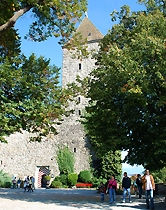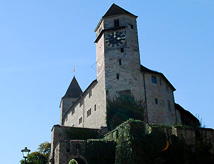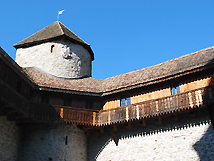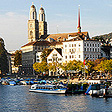RAPPERSWIL CASTLE
Deer Park and Polish Museum on Lake Zurich
 Rapperswil Castle stands high on the hill above the city of Rapperswil on the eastern shore of Lake Zurich, called the city of roses for the rose garden of its Capucin Wurmsbach Monastery. The fortress was first mentioned in records in 1229, built by Count Rudolf II and his son Rudolf III, of Rapperswil who gained the land in connection with the Abbey of Einsideln. The castle was built with sandstone quarried from the island of Lützelau in the lake, also used to construct the walls of the fortified city. When the original family control ended with the death of a teenage Rudolf V of Rapperswil in 1283, the castle passed into the hands of a different line of Rudolfs, German Emperor Rudolf I of Habsburg The Habsburgs were consolidating their holdings into Switzerland.
Rapperswil Castle stands high on the hill above the city of Rapperswil on the eastern shore of Lake Zurich, called the city of roses for the rose garden of its Capucin Wurmsbach Monastery. The fortress was first mentioned in records in 1229, built by Count Rudolf II and his son Rudolf III, of Rapperswil who gained the land in connection with the Abbey of Einsideln. The castle was built with sandstone quarried from the island of Lützelau in the lake, also used to construct the walls of the fortified city. When the original family control ended with the death of a teenage Rudolf V of Rapperswil in 1283, the castle passed into the hands of a different line of Rudolfs, German Emperor Rudolf I of Habsburg The Habsburgs were consolidating their holdings into Switzerland.
 In 1350, a revolt against the Habsburgs by the city region of Zurich led by Count Johann II, a descendant by marriage of the former counts of Rapperswil trying to regain the family dynasty was unsuccessful and the German Emperor ordered the town walls and the castle fortress destroyed. A carnival is still held in the town of Rapperswil on the occasion of Shrove Tuesday with its roots in the 14th Century siege on the city. The castle keep and defensive walls were rebuilt in 1354 by the Habsburg Duke of Austria, Abrecht II, built in a triangle shape with towers connected by crenelated walls.The family held the castle for another ninety years until 1442 when the line died out without heir and the castle became the property of the city of Rapperswill. Over the next three centuries under the Swiss Confederation, the castle was used as city administration, army garrison and as a jail, but fell into disuse and disrepair.
In 1350, a revolt against the Habsburgs by the city region of Zurich led by Count Johann II, a descendant by marriage of the former counts of Rapperswil trying to regain the family dynasty was unsuccessful and the German Emperor ordered the town walls and the castle fortress destroyed. A carnival is still held in the town of Rapperswil on the occasion of Shrove Tuesday with its roots in the 14th Century siege on the city. The castle keep and defensive walls were rebuilt in 1354 by the Habsburg Duke of Austria, Abrecht II, built in a triangle shape with towers connected by crenelated walls.The family held the castle for another ninety years until 1442 when the line died out without heir and the castle became the property of the city of Rapperswill. Over the next three centuries under the Swiss Confederation, the castle was used as city administration, army garrison and as a jail, but fell into disuse and disrepair.
 In 1870, the castle was leased by a Polish Count, Wladyslaw Broel-Plater, who had been living in exhile in Switzerland. The count restored the castle in a 19th century revival and to celebrate the culture of his native land, opened the Polish Museum which still remains, featuring artworks, and the stories of well-known Polish personalities and the Swiss-Polish relationship, as well as a library for research. On the north facing side with a walkway on the Lindendorf Plateau with views to the lake on either side is a deer park, with fallow deer grazing below the walls. The Rapperswil Castle today is used for social events, with a restaurant and banquet facilities including the Knights Hall, the Count’s Room and the Burgerstube for weddings and business gatherings. Dinner Murder shows are occasionally held at the castle as well an annual craft Beer Festival.
In 1870, the castle was leased by a Polish Count, Wladyslaw Broel-Plater, who had been living in exhile in Switzerland. The count restored the castle in a 19th century revival and to celebrate the culture of his native land, opened the Polish Museum which still remains, featuring artworks, and the stories of well-known Polish personalities and the Swiss-Polish relationship, as well as a library for research. On the north facing side with a walkway on the Lindendorf Plateau with views to the lake on either side is a deer park, with fallow deer grazing below the walls. The Rapperswil Castle today is used for social events, with a restaurant and banquet facilities including the Knights Hall, the Count’s Room and the Burgerstube for weddings and business gatherings. Dinner Murder shows are occasionally held at the castle as well an annual craft Beer Festival.
Visiting Rapperswil Castle
The Polish Museum is open from 1pm to 5pm Monday to Saturday amd 12pm to 5pm on Sunday April through October and 1pm to 5pm Saturdays and Sundays, November and March, closed except by appointment in January/February. Admission is 5 CHF for adults, 4 CHF for students and 3 CHF for children 7-16. Guided tours are offered for 100 CHF with advance notice. © Bargain
Travel Europe
Find best travel deals in Rapperswil on TripAdvisor
Web Info
Schloss Rapperswil
These
articles are copyrighted and the sole property of Bargain Travel
Europe and WLPV, LLC. and
may not be copied or reprinted without permission.
SEE
ALSO:
RAPPERSWIL WOODEN BRIDGE ON LAKE ZURICH



